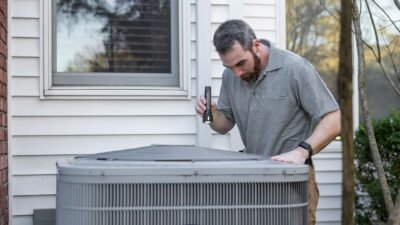When the cold season sets in, most households notice one thing right away: higher utility bills. Heating systems often run longer, small gaps in windows let cold air sneak in, and older equipment struggles to keep up. By the end of winter, these issues add up to wasted energy and unnecessary costs. The good news is that with a few simple habits, you can reduce these expenses without sacrificing comfort.
Winter maintenance doesn’t have to be complicated or expensive. Small actions like checking filters, sealing leaks, and giving your heating system the attention it needs can have a big impact. The key is consistency. Many homeowners overlook these steps because they seem minor, but when combined, they can save a noticeable amount of money throughout the season. This guide will walk you through practical habits that are easy to adopt and make a real difference in how much you spend to stay warm.
Schedule a Heating System Tune-Up
Even the best heating systems lose efficiency over time. Dust buildup, worn parts, and unnoticed issues can make the system use more energy than necessary. A professional tune-up before or during winter can prevent this. Technicians typically check for leaks, clean components, and test performance to ensure everything is working correctly.
Investing in a tune-up often saves money in the long run by reducing energy use and lowering the chance of costly repairs. It also keeps the system running safely, which is especially important during months of heavy use. If your heating system hasn’t been inspected in over a year, booking an appointment with a professional central heating services provider can be one of the smartest money-saving steps you take this season.
Check and Seal Drafts Around Windows and Doors
One of the most common reasons for heat loss in homes is drafts. Even a small gap around a window or door frame can let in a steady flow of cold air. This forces your heating system to work harder, raising your energy bills.
You can test for drafts by holding your hand near window edges or door frames on a windy day. If you feel cool air coming through, it’s time to seal those spots. Weatherstripping tape, caulking, or even fabric draft stoppers are simple and affordable fixes. In many cases, these small updates pay for themselves within a season because they cut down on wasted energy. Taking a couple of hours to check and seal openings can make your home more comfortable and more efficient right away.
Reverse Ceiling Fans to Circulate Warm Air
Many homeowners use ceiling fans only in summer, but they can be just as useful in winter. When set to spin clockwise at a low speed, ceiling fans push warm air that rises back down into the room. This makes the space feel warmer without adjusting the thermostat.
Changing the direction of your fan is simple—there’s usually a small switch on the motor housing. By running fans in reverse during cold months, you can make better use of the heat you’re already paying for. This habit doesn’t cost anything beyond the tiny amount of electricity needed to run the fan, yet it can help lower heating costs and improve comfort in larger rooms.
Insulate Pipes to Prevent Heat Loss and Freezing
Pipes that run through unheated spaces like basements, garages, or crawl spaces are vulnerable to freezing in winter. When water freezes inside a pipe, it can expand and cause cracks or bursts, which often lead to expensive repairs. Even if a pipe doesn’t burst, heat loss through exposed pipes makes your water heater work harder, increasing energy costs.
Adding foam or fiberglass insulation sleeves is a low-cost solution. They fit around pipes easily and provide an extra layer of protection against freezing temperatures. For outdoor pipes or those exposed to severe cold, heat tape can be used for added safety. By insulating pipes, you reduce energy waste and avoid the high costs of water damage from broken pipes.
Use Programmable or Smart Thermostats Wisely
Heating costs often rise because thermostats are left running at higher settings than necessary. A programmable or smart thermostat can prevent this by automatically adjusting the temperature based on your schedule. For example, lowering the temperature while you sleep or when you’re away during the day reduces energy use without affecting comfort.
Most experts recommend setting your thermostat around 18–20°C when at home and lowering it by a few degrees at night. Smart thermostats make these changes seamless by learning your habits and adjusting accordingly. However, it’s important not to overuse the “boost” or manual override functions, as frequent spikes in temperature reduce the benefits. Using these devices wisely can cut heating bills and create a more consistent indoor climate.
Check Attic and Basement Insulation for Heat Retention
Insulation plays a critical role in keeping heat inside your home. Warm air naturally rises, which means a poorly insulated attic allows heat to escape quickly. Basements and crawl spaces are other areas where heat can be lost, especially if walls or floors are left uninsulated.
You can check insulation levels yourself by looking into the attic. If the joists are visible, chances are the insulation layer is too thin. Adding insulation in attics, basements, or crawl spaces is a bigger investment than sealing a window draft, but it pays off over time through lower heating costs. Proper insulation can also extend the lifespan of your heating system since it won’t need to work as hard to maintain a stable temperature.
Maintain Humidity Levels for Better Comfort
Indoor air often becomes very dry in winter because of constant heating. Dry air feels cooler, which makes people turn up the thermostat to compensate. By keeping humidity at a healthy level, you can feel warmer at a lower temperature, saving energy and money.
A portable humidifier is an easy solution for a single room, while whole-house systems can be installed for larger spaces. In addition to lowering heating costs, proper humidity prevents dry skin, irritated sinuses, and even damage to wooden furniture or floors. Aim for a balanced range of 30–50 percent humidity for the best comfort and efficiency.
Winter energy bills don’t have to spiral out of control. Simple maintenance habits like sealing drafts, replacing filters, insulating pipes, and checking insulation make a noticeable difference in both comfort and costs. Tools like smart thermostats and humidifiers add another layer of savings when used correctly.
The key is to take small but consistent steps before and during winter, rather than waiting for problems to appear. Each habit contributes to reducing wasted energy and preventing expensive repairs. By adopting these practices, you can keep your home warm, safe, and efficient throughout the season while saving money at the same time.



